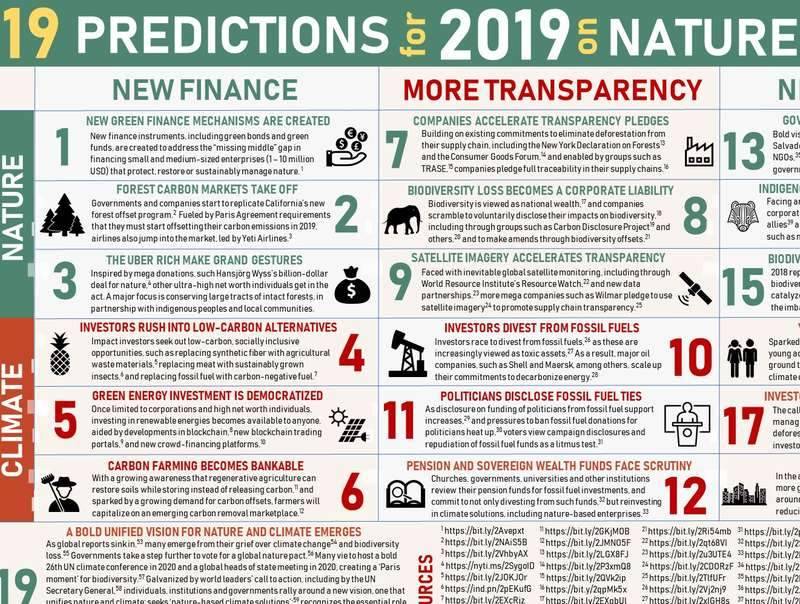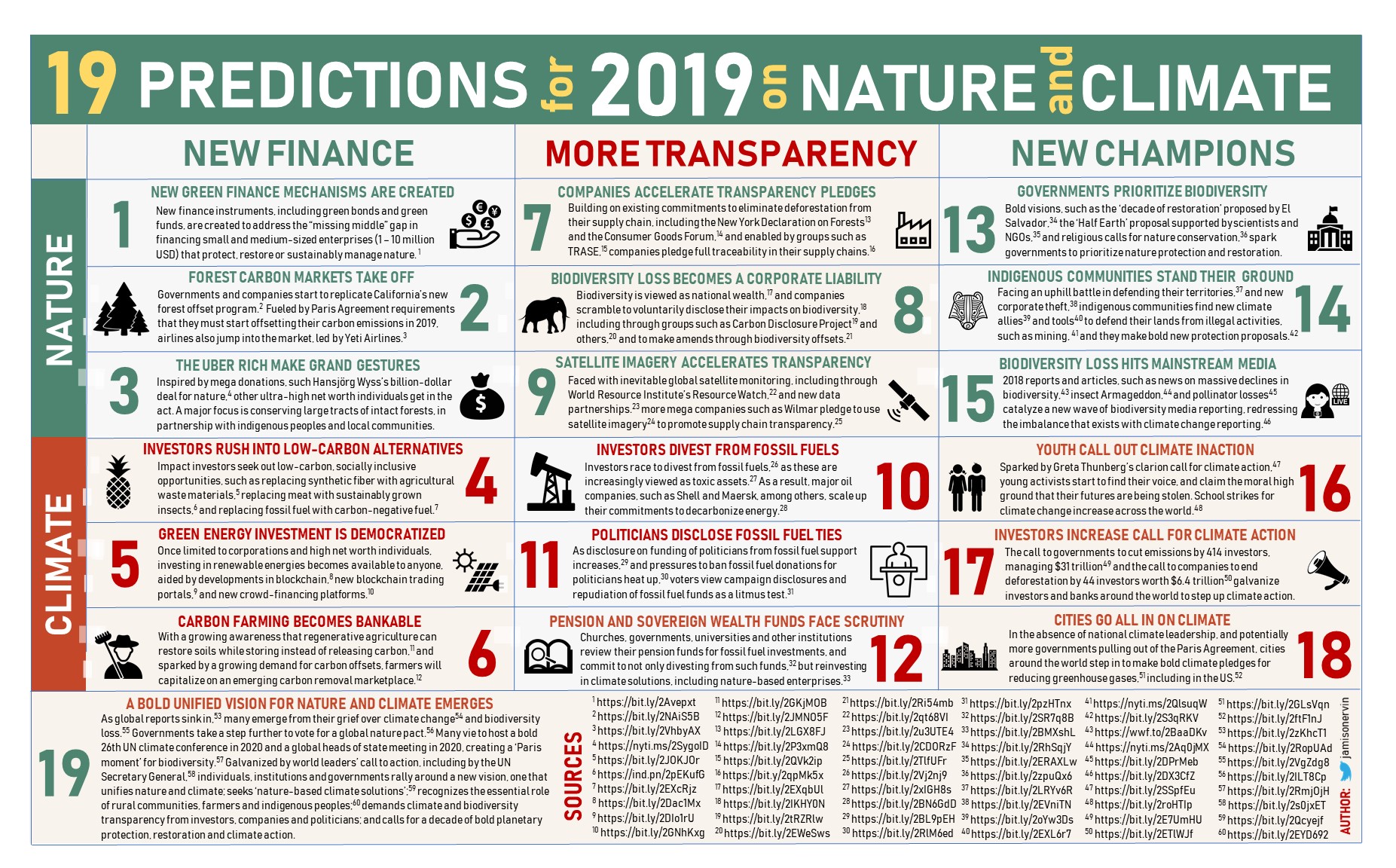
United Nations Development Programme’s manager, Jamison Ervin predicts what 2019 has in store when it comes to the climate and nature. We kick off number one with new green finance mechanisms, created to address the ‘missing middle’ gap in financing small and medium sized enterprises. Find out more here.
United Nations Development Programme’s manager, Jamison Ervin predicts what 2019 has in store when it comes to the climate and nature. We kick off number one with new green finance mechanisms, created to address the ‘missing middle’ gap in financing small and medium sized enterprises. Find out more here.

Jamison Ervin
Manager, Nature for Development, United Nations Development Programme
1. New green finance mechanisms are created
New finance instruments, including green bonds and green funds, are created to address the “missing middle” gap in financing small and medium-sized enterprises (1 – 10 million USD) that protect, restore or sustainably manage nature.[1]
2. Forest carbon markets take off
Governments and companies start to replicate California’s new forest offset program.[2] Fueled by Paris Agreement requirements that they must start offsetting their carbon emissions in 2019, airlines also jump in the market, led by Yeti Airlines.[3]
3. The uber rich make grand gestures
Inspired by mega donations, such Hansjörg Wyss’s billion-dollar deal for nature,[4] other ultra-high net worth individuals get in the act. A major focus is conserving large tracts of intact forests, in partnership with indigenous peoples and local communities.
4. Investors rush into fossil fuel alternatives
Impact investors seek out low-carbon, socially inclusive opportunities, such as replacing synthetic fiber with agricultural waste materials,[5] replacing meat with sustainably grown insects,[6] and replacing fossil fuel with carbon-negative fuel.[7]
5. Green energy is democratized
Once limited to corporations and high net worth individuals, investing in renewable energies becomes available to anyone, aided by developments in blockchain,[8] new blockchain trading portals,[9] and new crowd-financing platforms.[10]
6. Carbon farming becomes bankable
With a growing awareness that regenerative agriculture can restore soils while sequestering instead of releasing carbon,[11] and sparked by a growing demand for carbon offsets, farmers will begin to capitalize on the emerging carbon removal marketplace.[12]
7. Companies accelerate transparency pledges
Building on existing commitments to eliminate deforestation from their supply chain, including the New York Declaration on Forests[13] and the Consumer Goods Forum,[16] and enabled by groups such as TRASE.[15] companies pledge full traceability in their supply chains.[16]
8. Biodiversity loss becomes a corporate liability
Biodiversity loss is increasingly viewed as national wealth,[17] and companies scramble to voluntarily disclose impacts on biodiversity,[18] including through groups such as Carbon Disclosure Project[19] and others,[20] and to make amends through biodiversity offsets.[21]
9. Satellite imagery accelerates transparency
Faced with inevitable global satellite monitoring, including through World Resource Institute’s Resource Watch,[22] and new data partnerships.[23] mega companies such as Wilmar pledge to use satellite imagery[24] to promote supply chain transparency.[25]
10. Investors divest from fossil fuels
Investors race to divest from fossil fuels,[26] as these are increasingly viewed as toxic assets.[27] As a result, major oil companies, such as Shell and Maersk, among others, scale up their commitments to decarbonize energy.[28]
11. Politicians disclose fossil fuel ties
As disclosure on funding of politicians from fossil fuel interests increases,[29] and pressures to ban fossil fuel donations for politicians heat up,[30] voters view campaign disclosures and repudiation of fossil fuel funds as a litmus test.[31]
12. Pension and sovereign wealth funds face scrutiny
Churches, governments, universities and other institutions review their pension funds for fossil fuel investments, and commit to not only divest from such funds,[32] but to reinvest in climate solutions, including nature-based enterprises.[33]
13. Governments prioritize biodiversity
Bold visions, such as the ‘decade of restoration’ proposed by El Salvador,[34] the ‘half Earth’ proposal supported by scientists and NGOs,[35] and religious calls for nature conservation,[36] spark governments to prioritize nature protection and restoration.
14. Indigenous communities stand their ground
Facing an uphill battle in defending their territories,[37] and new corporate theft,[38] indigenous communities find new climate allies[39] and tools[40] to defend their lands from illegal activities, such as mining,[41] and they make bold new protection proposals.[42]
15. Biodiversity loss hits mainstream news
2018 reports and articles, such as news on massive biodiversity declines,[43] insect Armageddon,[44] and pollinator declines[45] catalyze a new wave of biodiversity reporting, redressing the imbalance that exists with climate change reporting.[46]
16. Youth call out climate inaction
Sparked by Greta Thunberg’s clarion call for climate action,[47] young activists start to find their voice, and claim the moral high ground that their futures are being stolen. School strikes for climate change increase across the world.[48]
17. Investors increase call for climate action
The call to governments to cut emissions by 414 investors, managing $31 trillion[49] and the call to companies to end deforestation by 44 investors worth $6.4 trillion[50] galvanize investors and banks to step up calls for climate action.
18. Cities go all in on climate
In the absence of national climate leadership in the US, Brazil, Australia and other countries, cities around the world step in to make bold climate pledges for reducing greenhouse gases,[51] including in the US.[52]
19. A bold new vision for nature and climate emerges
As global reports sink in,[53] many emerge from their grief over climate change[54] and biodiversity loss.[55] Governments take a step further to vote for a global nature pact.[56] Many vie to host a bold 26th UN climate conference in 2020 and a global heads of state meeting in 2020, creating a ‘Paris moment’ for biodiversity.[57] Galvanized by world leaders’ call to action, including by the UN Secretary General,[58] individuals, institutions and governments rally around a new vision, one that unifies nature and climate; seeks ‘nature-based climate solutions’;[59] recognizes the essential role of rural communities, farmers and indigenous peoples;[60] demands climate and biodiversity transparency from investors, companies and politicians; and calls for a decade of bold planetary protection, restoration and climate action.
REFERENCES